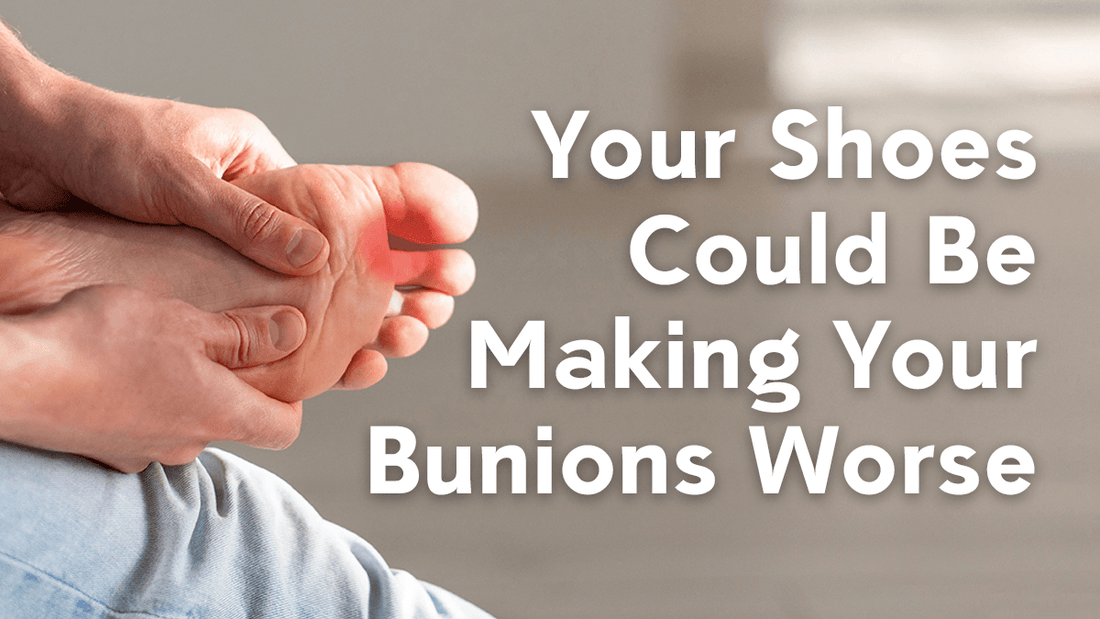Your Shoes Could Be Making Your Bunions Worse
- Bunion Friendly Shoes
- Bunions
- Foot Care
- Healthy Feet
- Pain Relief

Welcome to our four part series on easy steps you can take to relieve painful bunions! While we have many products that can help relieve bunion pain, there are actually some simple things you can do at home to make things a little easier on your feet. In part one of this series, we’ll take a look at how important footwear is to getting bunions under control!
Poorly fitted shoes are one of the most common causes of bunions. Not only can they cause this painful unappealing deformity, but with continued wear of the wrong shoes, the bunion will only continue to worsen over time.
Wearing shoes that are too narrow at the toes (aka - a narrow toe box) forces the big toe into an unnatural position. With time, the toe can adapt to this new position, forming a bunion. Narrow toed shoes should be avoided-including pointed toe ballet flats and cowboy boots.

A shoe with a slope will cause the foot to slide forward and be pushed into the front of the shoe, squeezing the toes together. High heels are the worst! Not only do they usually have a narrow toe box, but they also have a slope which will cause the toes to jam into the front of a narrow shoe.

This may surprise you, but memory foam shoes should also be avoided. While they do work well for some specific problems, such as an elderly person with heel pain caused by an atrophic fat pad, for most people these shoes should not be worn. Memory foam shoes and sneakers mold to your foot rather than support your foot. A hypermobile foot can also lead to a bunion deformity, so it’s always important to maintain a stable arch. Supporting the midfoot is necessary to avoid making your bunion worse.
Sandals are another culprit. While they don’t have the narrow toe box previously mentioned, most sandals have no arch support. However, there are a few brands of sandals on the market today that do have a built in orthotic type arch support. These are a great option for people that want to continue wearing sandals. If you are unsure which sandals have the built in orthotic arch support just ask your podiatrist! I recommend trying these sandals on before purchasing, because for some people the built in arch may actually be a little too high which can lead to rubbing and irritation in the arch of the foot.
Now that you know which shoes to avoid, check out part two for information on the best shoe options for bunions!
Author: Dr. Megan Ziemer, DPM
Wondering if you have a bunion? Check out our bunion quiz for more information and relief tips!
Continue Reading
View All
Our New Copper Infused Elbow Sleeve
We are so excited to introduce our new Copper Elbow Sleeve. Watch this short video to learn why this is the best cho...
- Joint Pain
- Pain Relief
Get the Heel Outta Here: Causes & At-Home Treatment for Dry, Cracked Heels
Heel fissures cause dry, cracked heels that can lead to pain and discomfort. Learn the causes of yellow, crusty heels...
- Dry Cracked Heels
- Healthy Feet
- Heel Pain
31 Reasons to Make Compression Gloves Your Soulmate
If you have hand pain, your soulmate might be a pair of compression gloves. Support, compression, copper compression ...
- Arthritis
- Carpal Tunnel
- Hand Pain
- Pain Relief